5 Easy and Delicious Homemade Applesauce Recipes You’ll Love
Applesauce is a timeless favorite that brings comfort and flavor to any meal. Whether served as a healthy snack, a side dish, or a baking ingredient, applesauce offers a naturally sweet and refreshing taste that everyone enjoys. While store-bought apple sauce is convenient, making your own homemade applesauce recipe allows you to enjoy a fresher, more flavorful version without any preservatives or artificial additives.
In this guide, we’ll walk you through how to make homemade applesauce using the best apples to create a smooth, delicious apple sauce that suits your taste. From selecting the right apple varieties to step-by-step cooking methods, you’ll discover tips and tricks to perfect your applesauce every time. Whether you prefer it chunky or smooth, sweetened or natural, this applesauce recipe will help you create a versatile treat perfect for any occasion.
Get ready to enjoy the simple pleasure of fresh, homemade applesauce that you and your family will love!
Table of Contents
Why Choose Homemade Applesauce?
Choosing a homemade applesauce recipe over store-bought options offers many important benefits. When you make your own apple sauce, you have full control over every ingredient that goes into it. This means you can avoid added preservatives, artificial flavors, and excessive sugars that are often found in commercial apple sauces. As a result, you get a healthier and fresher product that tastes better and is more natural.
Homemade applesauce also allows you to tailor the flavor and texture to your preferences. Whether you prefer your applesauce chunky or smooth, lightly spiced or plain, sweetened or naturally tart, making it yourself means you can create the perfect balance for your taste buds. Using fresh, high-quality apples enhances the flavor and aroma, giving your apple sauce a richness and vibrancy often missing from mass-produced versions.
Another advantage is cost savings. Making applesauce at home is often more economical, especially if you use apples you have on hand or buy them in bulk during apple season. It is also an excellent way to reduce food waste by using up apples that might otherwise go unused.
Beyond the practical benefits, preparing homemade applesauce is a simple and rewarding kitchen project. It connects you with fresh, wholesome ingredients and allows you to enjoy a delicious treat that the whole family will love. Plus, homemade apple sauce is versatile. It can be enjoyed as a snack, a side dish, or a natural sweetener in your favorite recipes.
Best Apples for Making the Perfect Applesauce Recipe
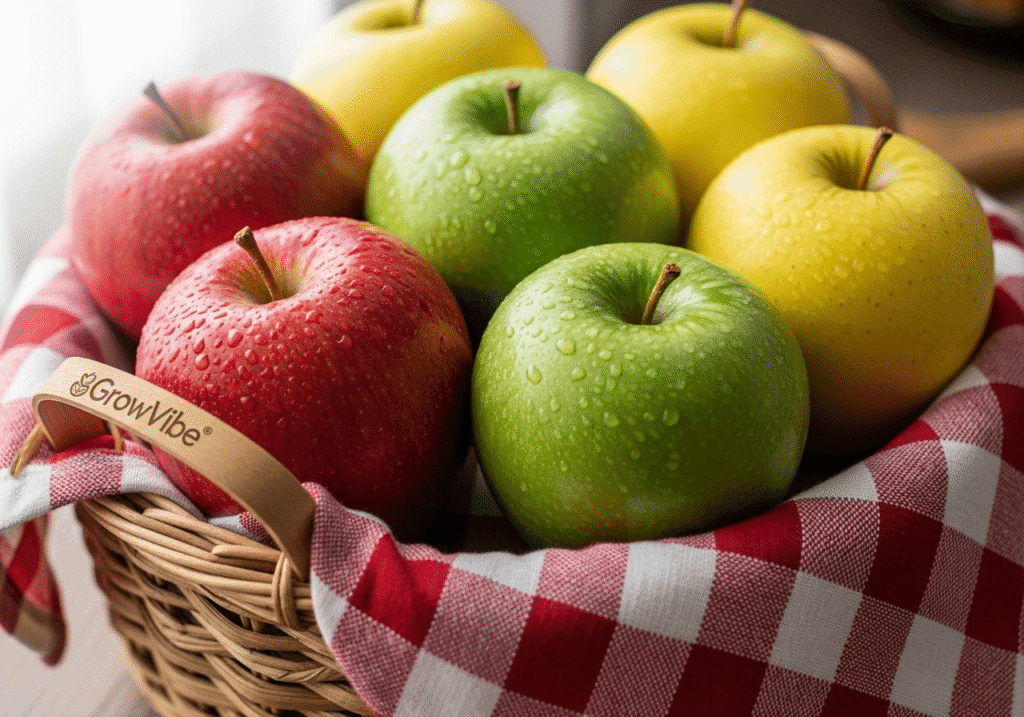
Choosing the right apples is key to making the best applesauce recipe. The flavor, texture, and sweetness of your homemade apple sauce will depend greatly on the types of apples you use. Different apple varieties offer unique qualities that can enhance your apple sauce.
For a naturally sweet and smooth apple sauce, apples like Fuji, Gala, and Honeycrisp are excellent choices. These apples are juicy and sweet, making your apple sauce flavorful without needing much added sugar.
If you prefer a tangier or more balanced flavor, consider mixing in tart apples like Granny Smith or Jonathan apples. These add a nice contrast and depth to the flavor of your apple sauce.
Combining sweet and tart apples often results in a well-rounded, delicious homemade applesauce recipe. The texture also varies by apple type — softer apples break down quickly, while firmer apples may leave your apple sauce a bit chunkier.
For detailed information about apple varieties and their best uses, you can visit the US Apple Association’s guide.
Selecting the best apples for your apple sauce will help you achieve a fresh, tasty, and naturally sweet apple sauce that everyone will love.
Essential Ingredients for a Flavorful Homemade Applesauce
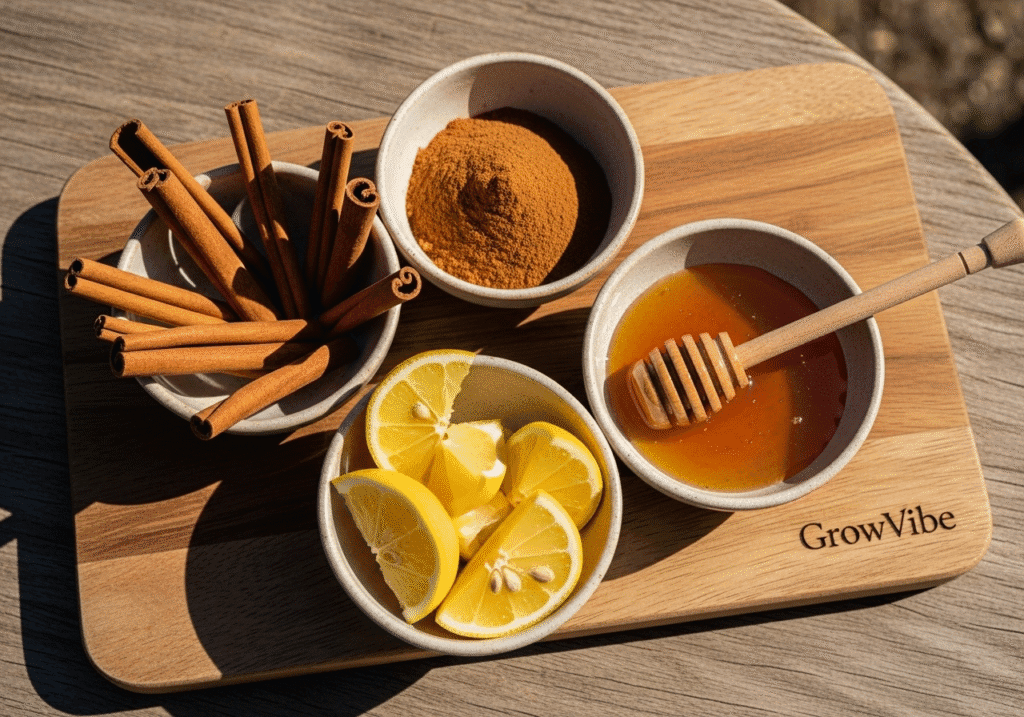
Making a flavorful homemade applesauce starts with a handful of simple, fresh ingredients. While apples are the foundation, adding a few complementary ingredients will enhance the taste and texture of your apple sauce.
Apples: Naturally, the most important ingredient is fresh, ripe apples. Choose a mix of sweet and tart varieties for balanced flavor. The quality of the apples directly impacts the final taste.
Liquid: To help cook down the apples and prevent sticking, use a small amount of water, apple juice, or even cider. This also adds a subtle layer of flavor and keeps the sauce moist.
Acid: A splash of lemon juice is essential to brighten the flavors and prevent the apples from browning during cooking. It adds a fresh, tangy note that complements the natural sweetness.
Spices: Adding cinnamon is a popular choice that brings warmth and depth. Depending on your preference, nutmeg, cloves, or allspice can also be used sparingly for extra complexity.
Sweeteners: Depending on the sweetness of your apples and your taste, you might add a bit of sugar, honey, or maple syrup. However, many prefer to keep their applesauce natural and unsweetened, letting the apples shine on their own.
When preparing your applesauce, these ingredients can be adjusted to create your perfect blend. The beauty of homemade apple sauce is that you control the flavors and textures, tailoring it exactly to your liking.
Step-by-Step How to Make Homemade Applesauce
Making your own applesauce at home is simple and rewarding. With just a few steps, you can create a fresh, flavorful apple sauce that’s perfect for snacking or cooking.
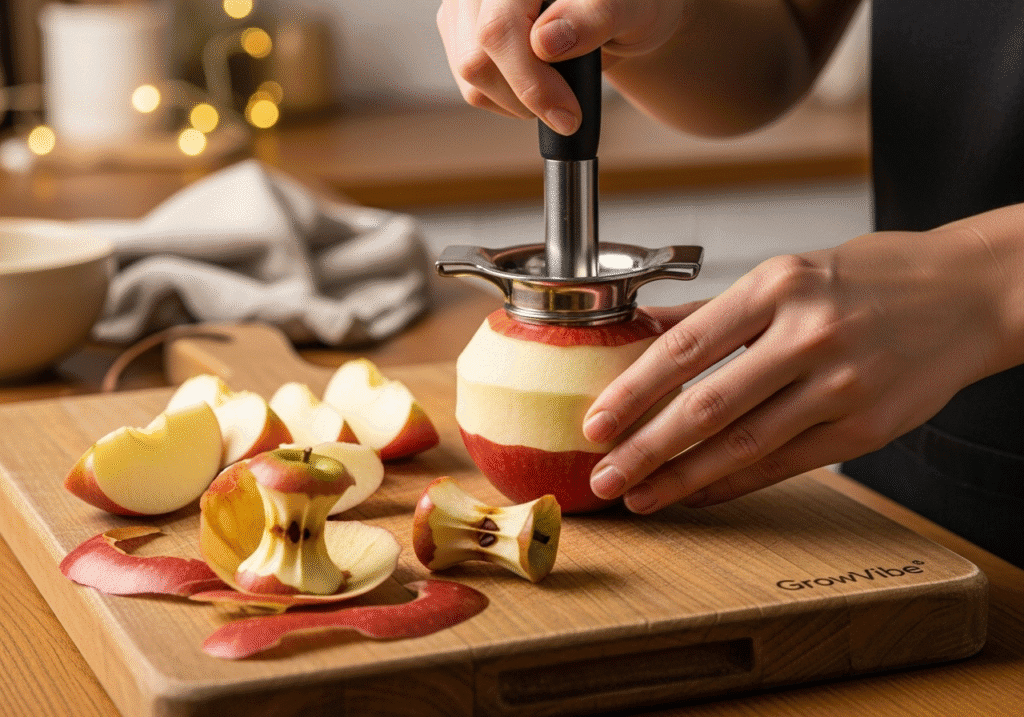
Prepare Your Apples
Start by washing, peeling, coring, and chopping about 4 to 6 medium apples. You can leave the skins on if you prefer a chunkier texture and extra fiber.
Choose Your Cooking Method
- Stovetop: Place the chopped apples in a large pot with a little water or apple juice. Cover and simmer over low heat for 20 to 30 minutes until the apples soften. Mash or blend the apples to your preferred consistency. For detailed stovetop tips, see this Serious Eats guide.
- Slow Cooker: Add apples, lemon juice, and optional spices to your slow cooker. Cook on low for 6 to 8 hours for tender apples and deep flavor. Here’s a helpful slow cooker applesauce recipe from The Kitchn.
- Instant Pot: Pressure cook the apples for about 10 minutes, then mash or blend. This method is quick and convenient.
Add Flavor
Once the apples are soft, add cinnamon, nutmeg, or sweetener like honey or maple syrup if desired. Stir well and taste to adjust the seasoning.
Final Touches
Let the applesauce cool, then transfer it to storage containers. Homemade apple sauce can be served warm or chilled.
For more on apple varieties to use, check the US Apple Association’s guide.
Variations on the Classic Applesauce Recipe
One of the best things about making your own applesauce is how customizable it is. You can easily adjust the texture, flavor, and sweetness to create your perfect homemade apple sauce.
Texture Variations:
- Smooth applesauce: For a creamy, smooth texture, use a blender or food processor to puree your cooked apples until silky.
- Chunky applesauce: If you prefer a bit more bite, mash the apples lightly with a potato masher and leave some small chunks for added texture.
Flavor Twists:
- Spiced applesauce: Add warming spices such as cinnamon, nutmeg, or cloves to give your apple sauce a cozy, aromatic flavor.
- Vanilla-infused: A splash of vanilla extract adds sweetness and depth without extra sugar.
- Citrus zing: Adding a bit of orange or lemon zest brightens the flavor for a fresh twist.
Sweetness Levels:
- Naturally sweet: Use sweet apple varieties and skip added sugar for a wholesome, natural taste.
- Lightly sweetened: Add a small amount of honey, maple syrup, or brown sugar to balance tartness.
- Spiced and sweet: Combine spices with a touch of sweetener for a dessert-like treat.
With these variations, your homemade applesauce recipe can be tailored to suit any preference or occasion. Experimenting with different combinations keeps this classic recipe exciting and fresh.
Tips for Perfect Texture and Flavor in Your Homemade Applesauce
Achieving the perfect texture and flavor in your homemade applesauce takes just a few simple tips:
- Adjust Cooking Time: Cooking your apples longer will create a thicker, more concentrated applesauce, while shorter cooking times result in a thinner, lighter sauce. Keep an eye on the apples as they soften to get your preferred consistency.
- Mash or Blend: For a chunky apple sauce, use a potato masher to gently mash the cooked apples. For a smooth sauce, blend with an immersion blender or food processor. Avoid over-blending if you want to retain some texture.
- Balance Sweetness: Taste your applesauce during cooking. If the apples are tart, add a small amount of natural sweetener like honey or maple syrup. Using a mix of sweet and tart apples also helps balance flavors naturally.
- Add Spices Gradually: Start with a small amount of cinnamon or other spices and adjust to taste. Spices can easily overpower if added too early or in large quantities.
- Prevent Browning: To keep your applesauce looking fresh, add a splash of lemon juice during or after cooking. This also adds a nice tang that enhances flavor.
- Avoid Common Mistakes: Don’t rush peeling and coring to avoid bitterness from seeds or skin. Also, avoid adding too much water, which can make the sauce watery and dilute the flavor.
By following these tips, you can craft a homemade applesauce recipe that’s perfectly suited to your taste and texture preferences.
How to Store Homemade Applesauce Properly for Freshness and Longevity
Storing your homemade applesauce the right way is essential to preserve its fresh flavor, texture, and nutritional value. Whether you plan to enjoy it within a few days or keep it for longer, following proper storage methods will help you get the most out of your delicious apple sauce.
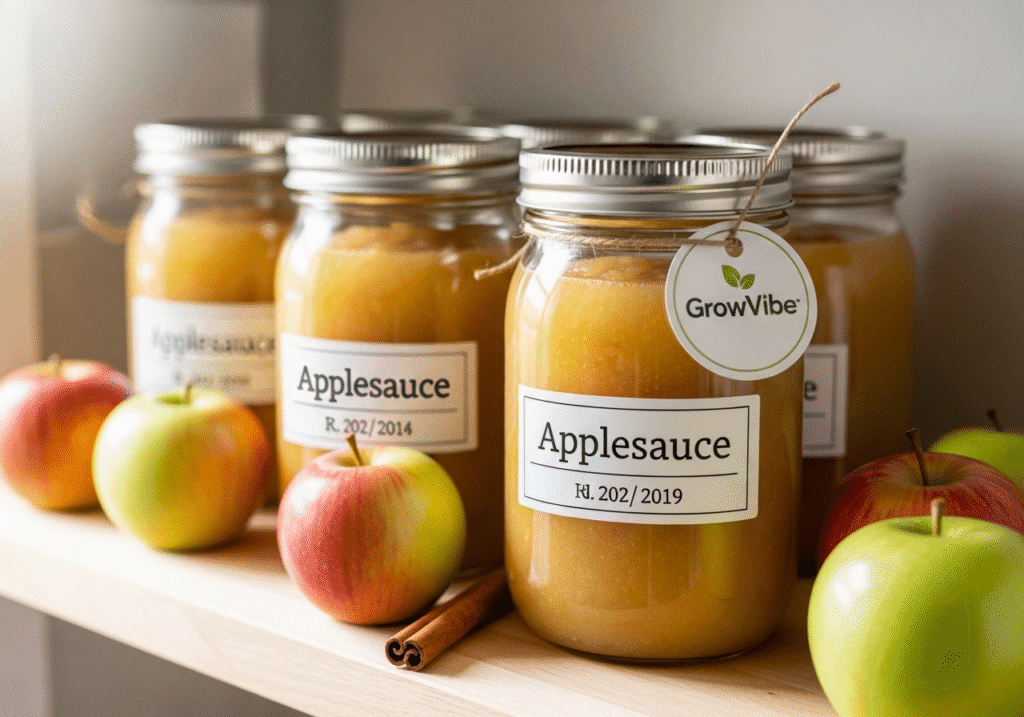
Choosing the Right Containers
Use clean, airtight containers made of glass or BPA-free plastic. Glass jars are ideal because they do not absorb odors or stains and help maintain the applesauce’s original taste. Mason jars with tight-fitting lids are perfect for both refrigeration and freezing. If you prefer plastic containers, make sure they seal well to avoid air exposure.
Refrigeration Tips
Fresh homemade applesauce can safely stay in the refrigerator for 7 to 10 days. Keep the container tightly sealed to prevent the sauce from absorbing other odors or moisture that could lead to spoilage. Always use a clean spoon when serving to avoid introducing bacteria.
Freezing for Longer Storage
If you want to store your applesauce for several months, freezing is the best option. Transfer the sauce into freezer-safe containers or heavy-duty resealable freezer bags. Leave about an inch of space at the top to allow for expansion during freezing, which prevents cracking or breaking of containers.
Frozen applesauce can last for up to 6 months without losing much flavor or quality. For convenience, you can freeze applesauce in smaller portions using ice cube trays. Once frozen, transfer the cubes into labeled freezer bags for easy thawing of just the amount you need.
Thawing and Using Frozen Applesauce
When ready to use frozen applesauce, thaw it overnight in the refrigerator or gently warm it on the stove over low heat. Stir well to restore smoothness, as freezing can sometimes cause slight separation.
Label and Date Your Containers
Always label your containers with the date you made or froze the applesauce. This simple step helps you keep track of freshness and ensures you use the oldest batches first to minimize waste.
By following these storage tips, your homemade applesauce recipe will stay fresh, tasty, and ready to enjoy whenever you want.
Serving Ideas and Uses for Homemade Applesauce
Homemade applesauce is incredibly versatile and can be enjoyed in many delicious ways. Whether you eat it straight from the jar or use it as an ingredient, apple sauce adds flavor and nutrition to your meals.
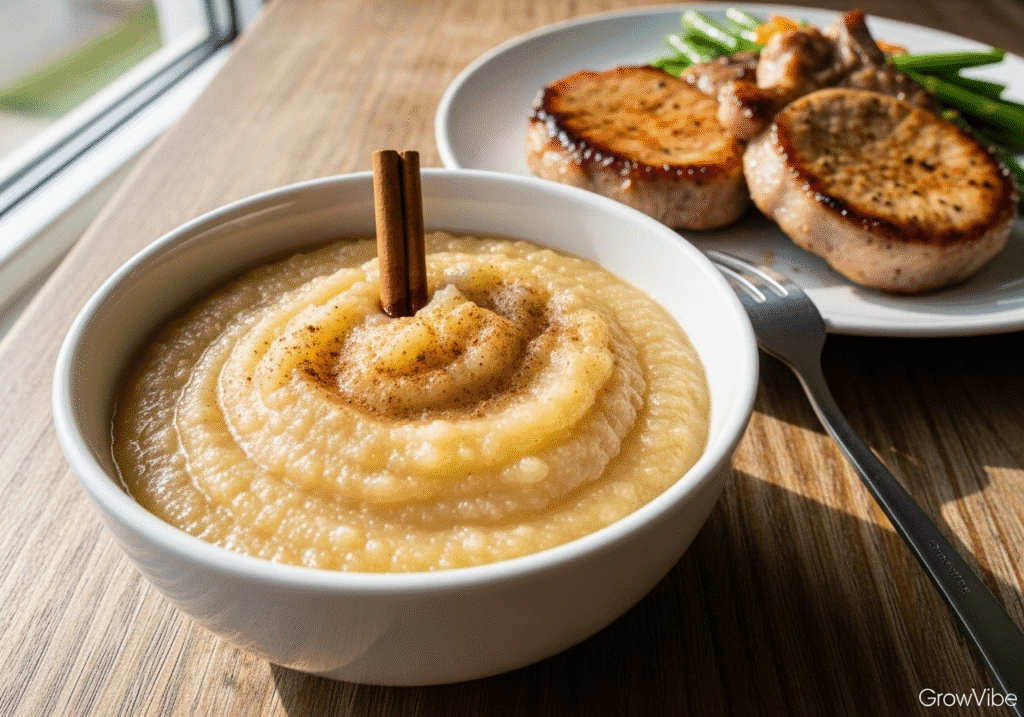
As a Snack or Side Dish
Enjoy your applesauce plain or chilled as a healthy, refreshing snack. It pairs wonderfully with breakfast items like oatmeal or yogurt. You can also serve it as a side dish alongside pork chops, roasted chicken, or sausages, where its natural sweetness complements savory flavors perfectly.
Baking Ingredient
Use your homemade applesauce as a natural substitute for oil or butter in baking recipes. It adds moisture and subtle sweetness to muffins, cakes, pancakes, and breads while reducing fat content. This makes for healthier treats without sacrificing flavor.
Sweetener Alternative
Replace sugar or syrups with applesauce in smoothies, sauces, or dressings to add natural sweetness and extra fiber. It works well in homemade granola bars, salad dressings, and even marinades.
Creative Recipes Using Applesauce
- Apple Sauce Pancakes: Mix applesauce into your pancake batter for a tender, flavorful breakfast.
- Applesauce Muffins: Incorporate it into muffin recipes for added moisture and sweetness.
- Homemade BBQ Sauce: Combine applesauce with spices and vinegar to make a tangy barbecue sauce.
- Fruit Dip: Blend applesauce with cream cheese or yogurt for a tasty dip for fresh fruits.
With so many ways to enjoy it, your homemade applesauce recipe becomes more than just a simple treat—it’s a kitchen staple that enhances meals and snacks throughout the day.
Nutritional Benefits of Homemade Applesauce
Homemade applesauce offers a range of nutritional benefits that make it a healthy choice for snacks and meals. When you prepare your own apple sauce, you avoid added sugars and preservatives often found in store-bought versions, making it a wholesome option for the whole family.
High in Fiber
Apples are naturally rich in dietary fiber, especially if you leave the skins on when making your apple sauce. Fiber supports healthy digestion, helps regulate blood sugar, and promotes feelings of fullness.
Low in Calories
A typical serving of homemade applesauce is low in calories, making it a guilt-free snack or addition to meals. It provides natural sweetness without extra fat or empty calories.
Rich in Vitamins and Antioxidants
Applesauce contains important vitamins such as vitamin C, which supports the immune system, and antioxidants that help protect the body from harmful free radicals.
No Added Sugars
By making your own apple sauce, you control the amount of sweetness. Many recipes use no added sugars, relying solely on the natural sugars in the apples, making it suitable for people watching their sugar intake.
Versatile for Special Diets
Homemade applesauce is naturally gluten-free, vegan, and suitable for most dietary needs. It can be enjoyed by children, adults, and those with dietary restrictions.
Incorporating homemade applesauce into your diet is an easy way to enjoy a tasty, nutritious food that supports overall health.
Frequently Asked Questions About Applesauce Recipe
How long does homemade applesauce last?
Properly stored in the refrigerator, homemade applesauce typically lasts about 7 to 10 days. If frozen, it can stay good for up to 6 months.
Can I use frozen apples to make applesauce?
Yes! Frozen apples are a convenient option and work well for making a homemade applesauce recipe. Just thaw them before cooking.
What is the best apple to use for apple sauce?
A mix of sweet apples like Fuji or Gala and tart apples like Granny Smith usually makes the best applesauce. This balance helps create a flavorful apple sauce with natural sweetness and tang.
Do I need to peel the apples for homemade applesauce?
Peeling is optional. Leaving the skins on adds extra fiber and nutrients, but peeling can create a smoother texture if preferred.
How do I make homemade applesauce without added sugar?
Use naturally sweet apples and skip any added sweeteners. The cooking process enhances the apples’ natural sugars, making a delicious, sugar-free apple sauce.
Can I make chunky applesauce or only smooth?
You can make either! For chunky applesauce, mash the cooked apples lightly. For smooth applesauce, blend or puree to your desired consistency.
Final Thoughts
Making a homemade applesauce recipe is a simple, rewarding way to enjoy fresh, wholesome flavors right from your kitchen. With just a few ingredients and some easy steps, you can create a versatile apple sauce that’s perfect as a snack, baking ingredient, or side dish.
By choosing the best apples, following trusted methods, and storing your apple sauce properly, you’ll enjoy delicious results every time. Try experimenting with different spice blends and sweetness levels to make this classic recipe uniquely yours.
We hope this guide inspires you to make fresh, tasty applesauce at home and explore many more delicious recipes here at GrowVibe.net.
Related Articles from GrowVibe.net
To continue your kitchen adventures, check out these helpful articles that complement your homemade applesauce recipe:
- Healthy Smoothie Recipes to Boost Your Energy — Fresh ideas to enjoy more fruit and nutrients daily.
- Easy Air Fryer Snacks for Busy Days — Quick and delicious snack recipes perfect for any time.
- Simple Bowl Recipes for Meal Prep — Nourishing bowls that make healthy eating effortless.




